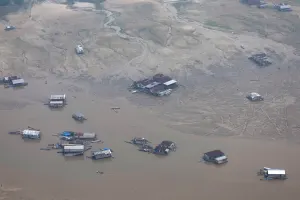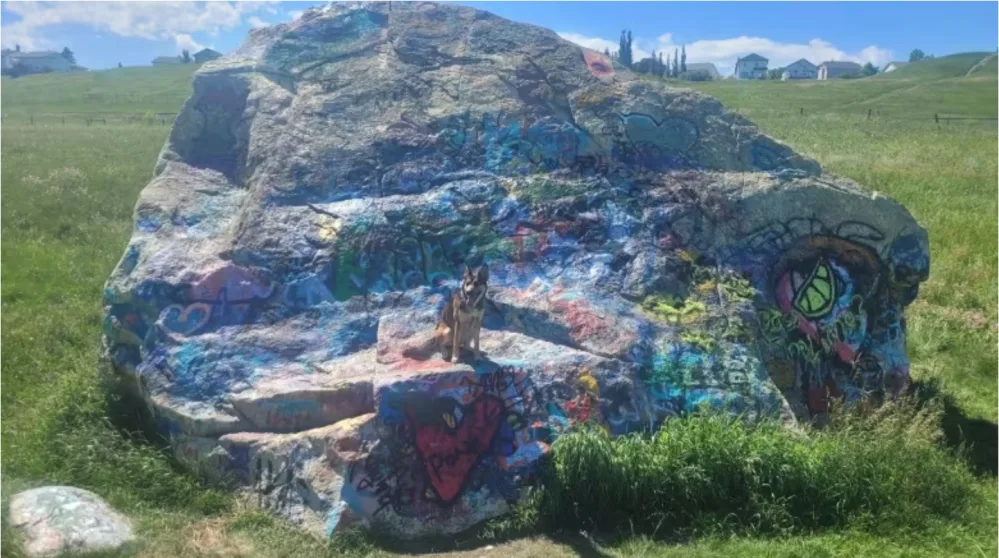
Forget the Rockies, these Alberta rocks are erratic and bolder than most
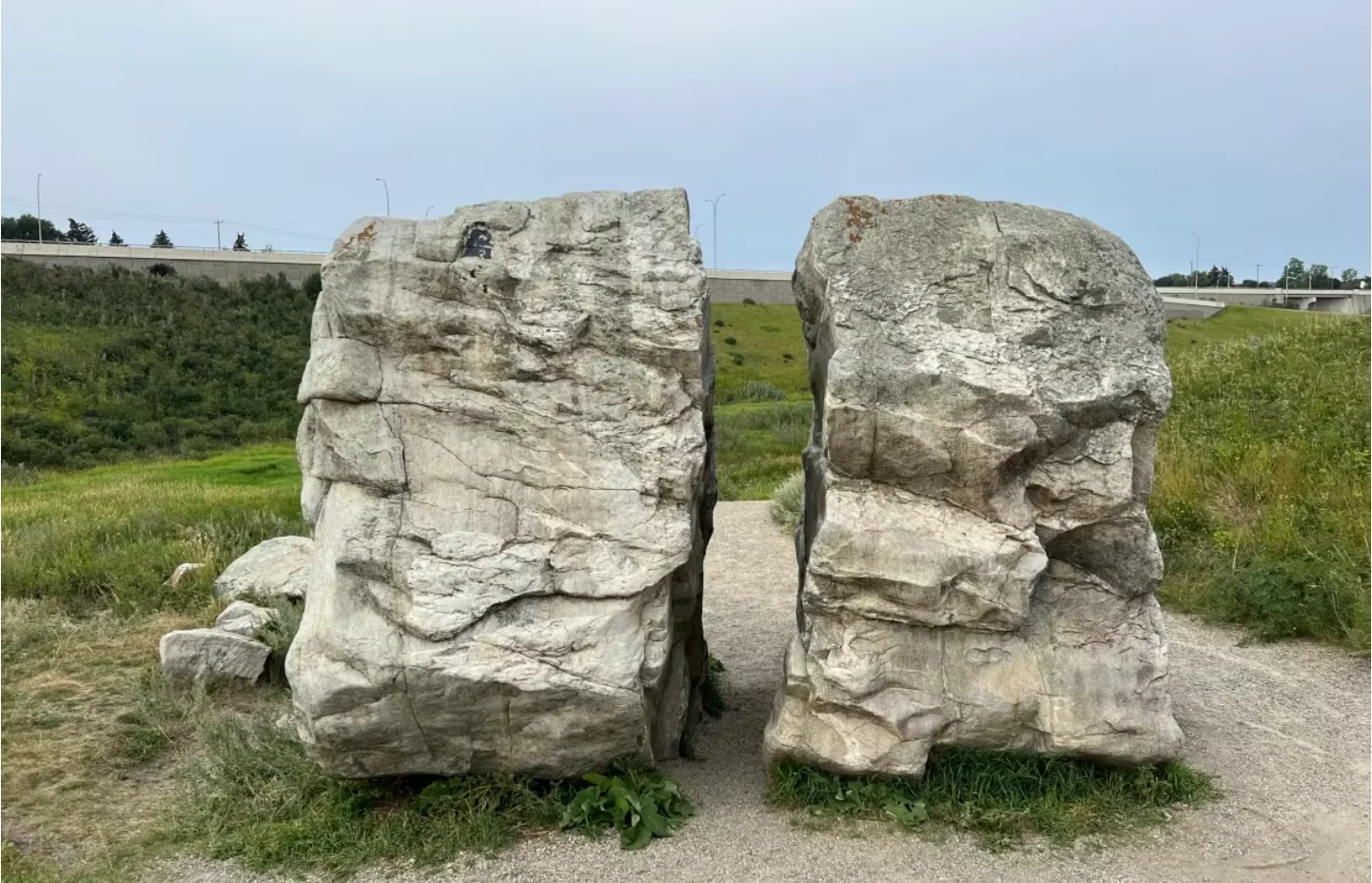
Split rock can be found in Confluence Park in Calgary's Beddington Heights neighbourhood. (Submitted by Dale Leckie via CBC)
If you're taking a walk just east of Calgary's Coventry Hills neighbourhood, you may dismiss it as a regular old rock covered in graffiti.
But to Lincoln Friske, it's a local treasure.
A large erratic boulder sits just past Nose Creek Park. Friske visits the massive rock on his daily dog walks, and he decided recently to create a digital 3D model of it so others could appreciate it, too.
"It's set up just like an anomaly in the middle of this massive park," he said in an interview on the Calgary Eyeopener. "Most people didn't even know there was this graffiti erratic in our own backyard."
Erratics are stones, boulders or big blocks picked up and moved by glaciers from one place to another during the last ice age.
There are thousands dotting the Foothills, part of a 600-kilometre section known as the Foothills Erratics Train. It runs from about Hinton, Alta., all the way down to the Montana border.
Check out a 3D model of the Nose Creek rock
Eva Enkelmann, an associate professor in the University of Calgary's department of geoscience, says the boulders typically look out of place.
"It almost looks like it fell out of the sky. What that means is it doesn't really match with the rocks you find in that area," she said.
The stones are typically white, grey or slightly pink.
They're made of quartzite — or cemented sand grains — dating back some 500 million years, according to Dale Leckie, geologist and author of The Scenic Geology of Alberta: A Roadside Touring And Hiking Guide.
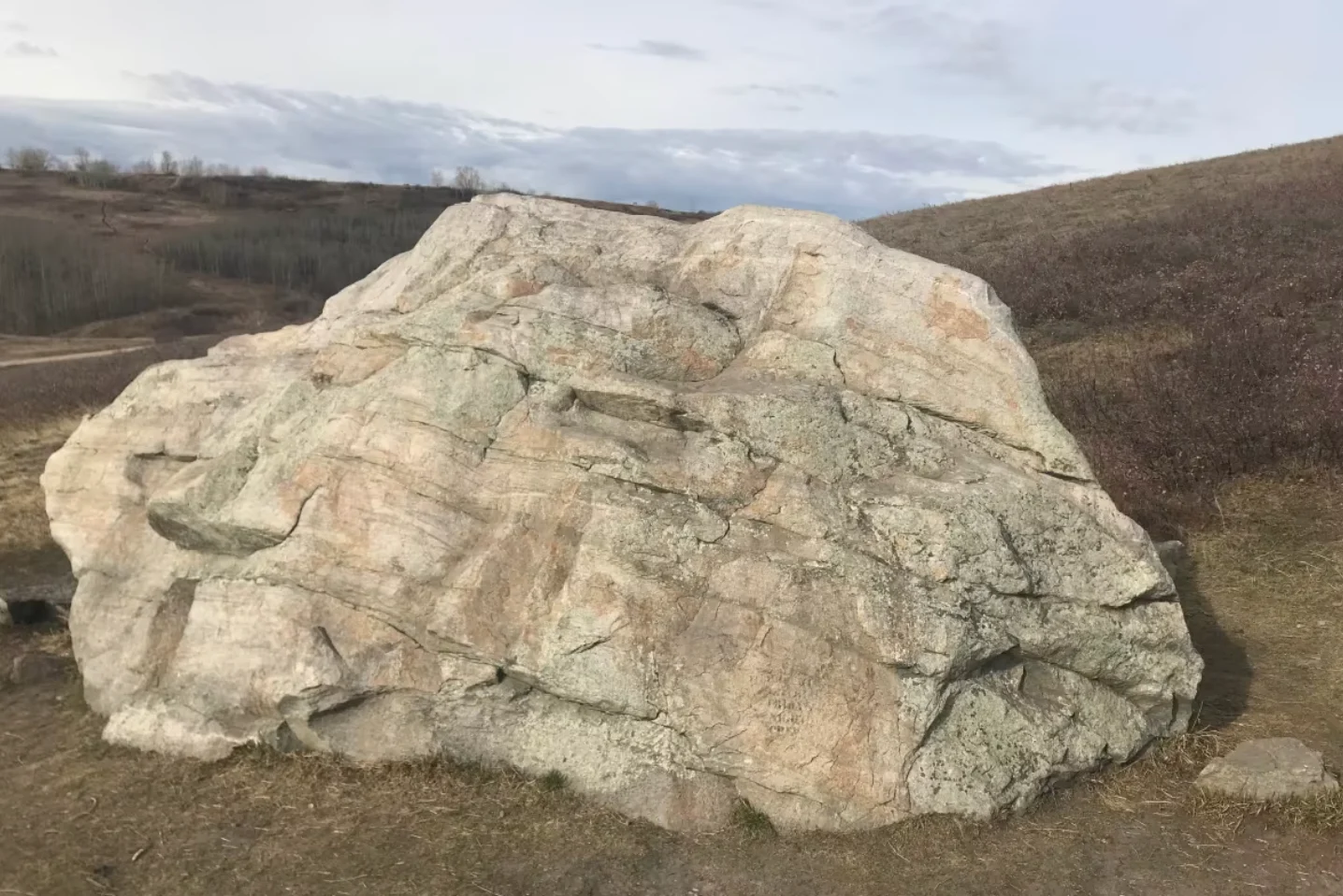
This large boulder sits in Nose Hill Park, part of the Foothills Erratics Train. (Submitted by Dale Leckie via CBC)
Researchers have traced the material back to Mount Edith Cavell in Jasper National Park, about 300 kilometres northwest of Calgary.
"They are a very distinctive type of rock," Leckie said.
"You can see features inside them, which geologists call cross-beds. They're structures from the waves and the tides when they were deposited."
So how did they get here?
About 20,000 years ago, a landslide occurred in Jasper National Park.
The tumbling boulders fell onto valley glaciers in the Athabasca River valley. They floated north, then east, then bumped into the Laurentide ice sheet, which covered most of Canada at the time, and were redirected southward, Leckie said.
Over time, they became scattered across the Foothills.
"When the ice melted, eventually it just let them down, I'll say almost gently, onto the landscape, slipping, sliding back and forth," Leckie said.
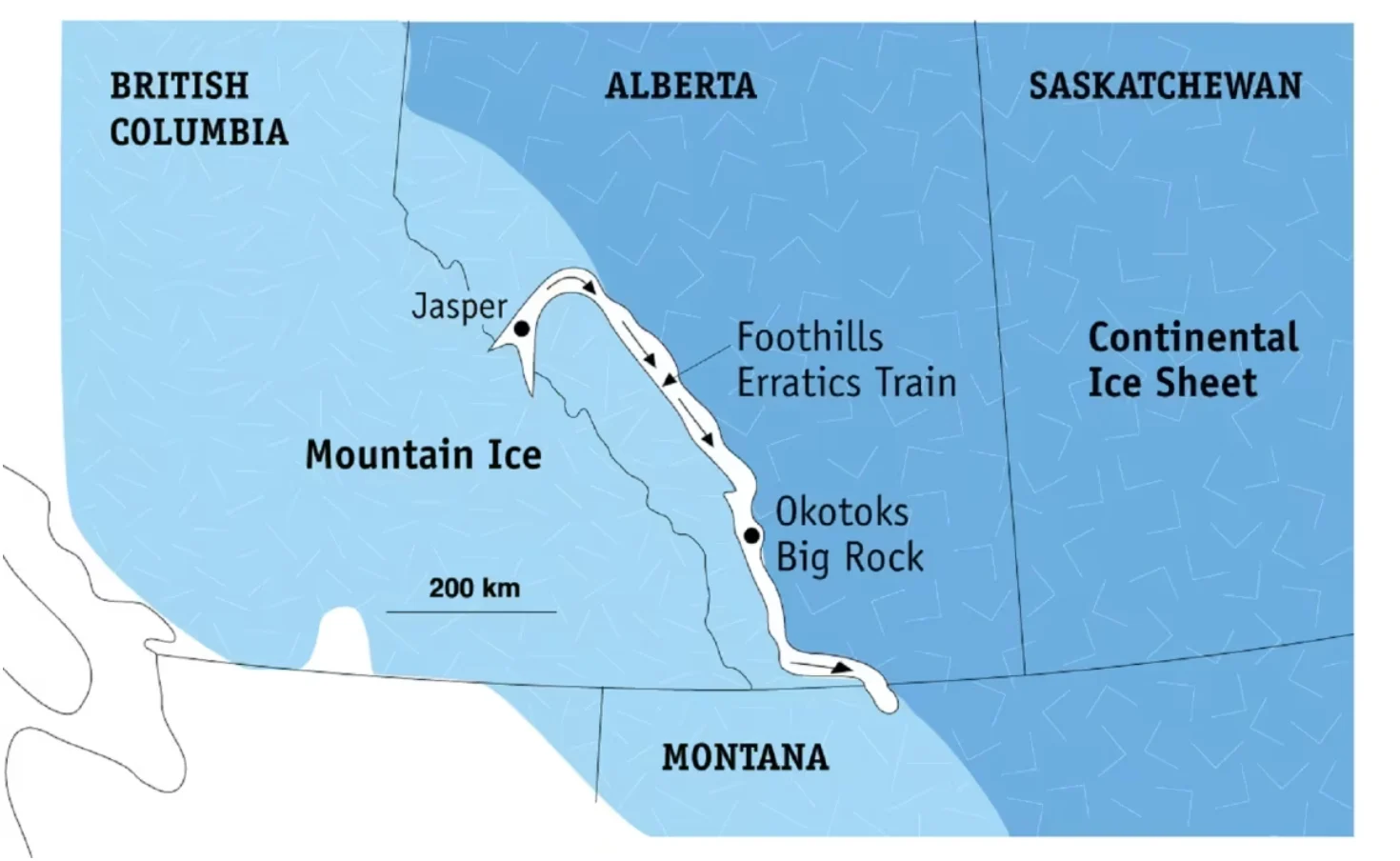
The Foothills Erratics Train runs from about Hinton, Alta., all the way down to the Montana border. (Government of Alberta)
Most of the erratic boulders landed in their current resting spots about 16,000 years ago.
Another distinctive feature is how solid the erratics are, Enkelmann said.
"Only rocks that are very, very hard actually survive such a long transport," she said. "The river would usually round the boulders and eventually they turn into pebbles."
If you look closely, though, some of the boulders do have some round edges along their lower portions.
That's because hundreds of years ago, bison used to rub up on the boulders to get rid of their winter coats, Leckie said, creating more polished bits. They also created depressions around the boulders known as buffalo wallows.
Where are they?
You can stumble upon an erratic boulder in many farmers' fields running along the Rocky Mountains, Leckie said, but some of the rocks have become famous landmarks.
The largest and most well-known example would be the Okotoks erratic — also known as Big Rock — which is about the size of a three-storey apartment building. A 3D model of the erratic is also available courtesy of the University of Calgary.
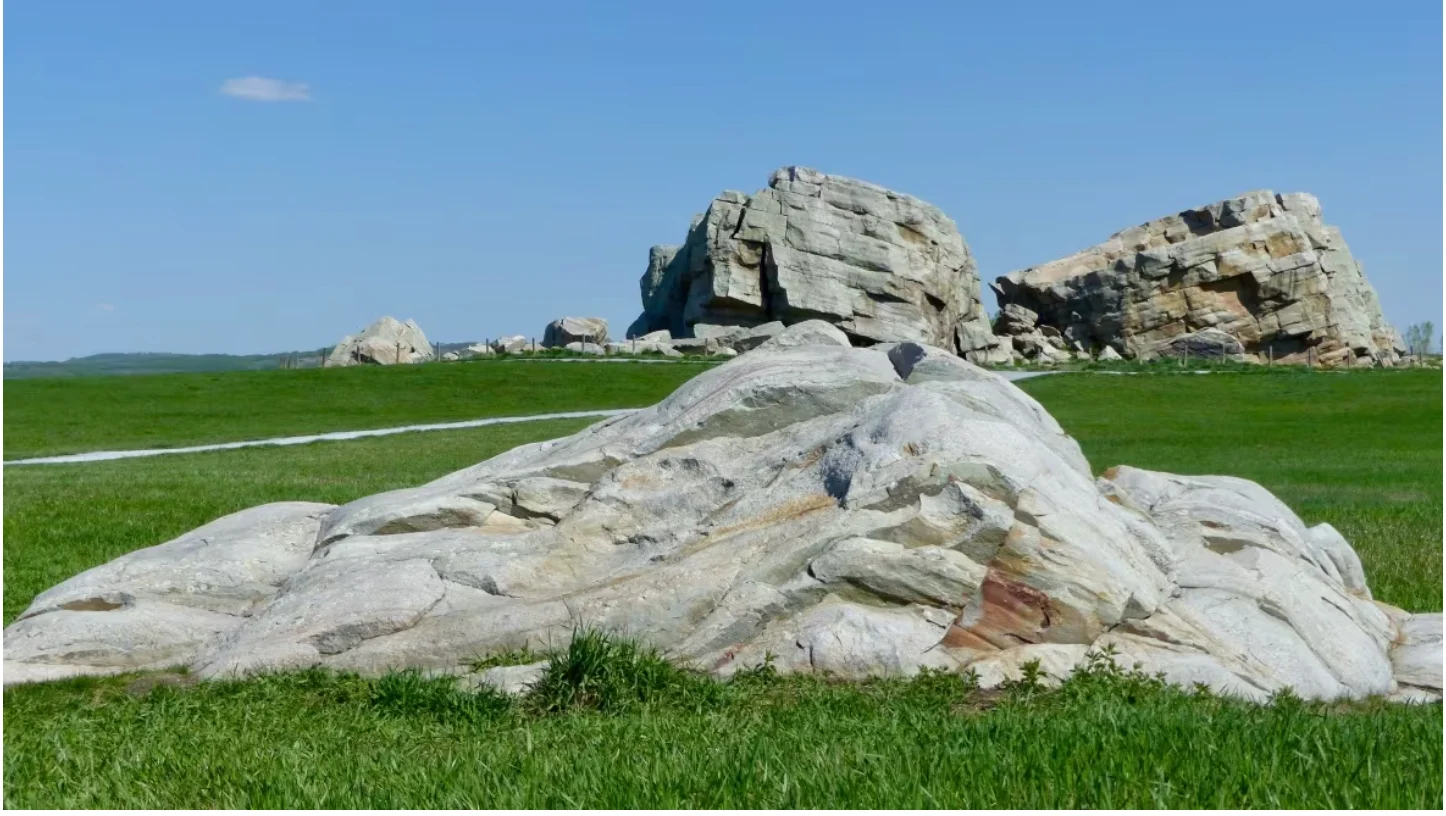
The Okotoks erratic is protected by the Government of Alberta for its geological and cultural importance. (Submitted by Dale Leckie via CBC)
The province designated Big Rock a provincial historic resource in 1978 to protect its geological and cultural importance.
"I think they're so interesting because they're just giant blocks," Leckie said.
"They really grab your attention … they just jump out in the landscape because they're standing high almost like sentinels."
Several notable erratics are located in Calgary, including the one documented near Coventry Hills.
One sits on top of Nose Hill Park. Another, known as Split Rock, is in the city's northeast, just off Harvest Hills Boulevard and Beddington Trail N.W.

Lincoln Friske's dog, Emzy, sits on the erratic boulder in his neighbourhood. (Submitted by Lincoln Friske via CBC)
Leckie has seen others in a McKenzie Lake playground and a Tuscany rest area. In Panorama Hills, there's an erratic — sometimes referred to as crater rock — in a small park.
There are hundreds more, says Enkelmann, and once you're aware of them, you'll start to notice them everywhere.
"For me, it's fascinating that you can weave this whole story by looking at these erratics here in the city, where we are relatively far away from the mountains but we have this evidence," she said.
This article, written by Taylor Simmons, was originally published for CBC News. Contains files from Nathan Godfrey, Loren McGinnis.









